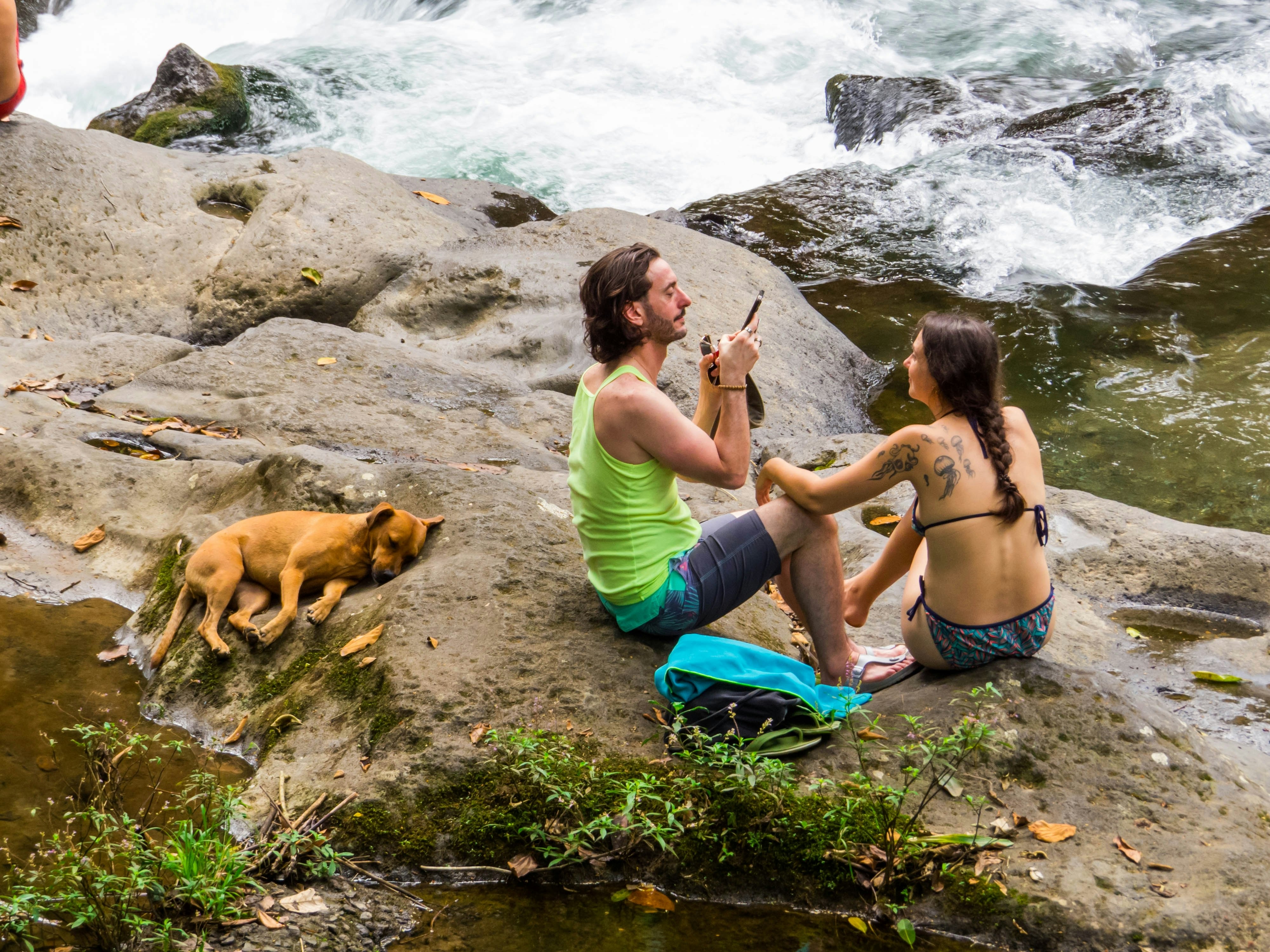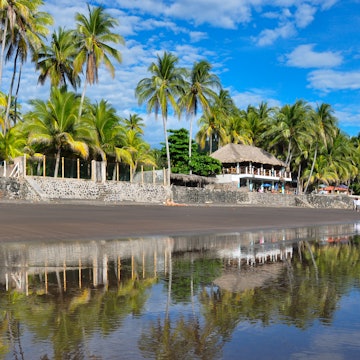
How to get your cell phone connected in Costa Rica: eSIMs, wi-fi and mobile networks

Jan 15, 2025 • 8 min read

With fabulous nature and pristine jungles, Costa Rica offers the ultimate escape. Still, if you want to stay connected on your next trip there, here’s how. Jakub Maculewicz/Shutterstock
Costa Rica is the ultimate destination for outdoor adventure and discovery, and escaping the crush of the modern world is a key selling point of any getaway to this Central American gem. And yet…
We still want to keep in touch with friends and family, navigate the landscape and share updates from our fabulous adventures. So never fear: for all of its wild and remote corners, staying connected in Costa Rica is fairly straightforward. Read on for a complete guide to staying connected via wi-fi, eSIM and mobile networks during your trip here.
Will my phone work in Costa Rica?
Yes, your phone will work in most places in Costa Rica – though the service and cost can vary widely. Check your provider’s options for international service to avoid expensive roaming charges, which can come as an unpleasant surprise when you return and see your next bill.
Both AT&T and Verizon offer a $12 daily travel pass that lets you tap into your domestic plan. Alternatively, Verizon has a monthly plan that includes 20GB of high-speed data (plus calls) for $100. T-Mobile’s Go5G plans all include international coverage (5 to 10GB of high-speed data) without any special arrangements, and you can add on a travel pass (for one day, five days or 30 days) for more data and free calls.
How far does your data go? It varies, of course, but 1GB is generally good for one hour of video streaming, several hours of web surfing, or thousands of emails or WhatsApp messages. Navigation apps like Google Maps or Waze (which are critical in Costa Rica) consume about 5MB per hour.

What mobile networks are available in Costa Rica?
In Costa Rica, Kölbi (ICE) is the state-owned carrier, with the widest area of coverage. Other major mobile networks include Claro and Liberty, with each company’s quality of coverage varying between regions. If you’re going to be staying in one particular region, we recommend consulting the nPerf map to see what company has the best coverage.
These providers offer 3G and 4G LTE service around the country. Several companies are doing trials of 5G networks but they are in very limited areas (mainly in San José, Cartago and Puerto Limón).
Is eSIM available in Costa Rica, and how does it work?
The most convenient and cost-effective option for staying connected on the road is eSIM, a digital SIM that is built into newer devices and which can be activated without the need to insert a physical card. It’s easy to sign up for your service of choice by simply scanning a QR code. Once in-country, you can connect to any available network.
A big advantage with this arrangement is that you can still receive calls and messages on your primary number, while using your Costa Rica eSIM for data. Most recent iPhone and Android devices are compatible with eSIMs, though you should be sure to check your device before you set out on your trip.
Kölbi and Claro both offer eSIM packages with a variety of prepaid options, and the rates are comparable to a regular SIM card. But remember that you have to go to an in-country shop or service center to procure them.
You can avoid that hassle if you opt for an international eSIM provider. In this case, you can purchase and install an eSIM before your trip, which means you’ll be ready to roll as soon as you land in Costa Rica. We recommend Saily as our eSIM partner: Saily rates in Costa Rica start at $7.59 for 1GB of data, or $25.64 for 5GB. Use code LP5 to receive 5% off your Saily mobile data plan.

How can I get a local SIM card?
If you plan to use a local SIM card, first make sure your phone is not locked by your provider.
Travelers flying into San José International Airport can buy a prepaid SIM card at the Claro stand near the baggage claim at SJO. Otherwise, SIM cards are available at ICE offices, dedicated retail stores and most phone stores, computer stores or even supermarkets. Staff at the store can help set up your phone and make sure it works.
An important note: wherever you buy a SIM card, you will need to show your passport. You should also be prepared to pay in cash.
Also be sure to make note of your local phone number on your receipt (take a picture!), as you’ll need it to load more data or minutes.
Each provider offers various prepaid plans (prepago). Kölbi’s SIM Turista includes 5GB of internet data, an additional 5GB for specific apps like Waze and WhatsApp, and 100 minutes of calls, all for 12,000 colones ( US$24). Claro offers 2GB of data (plus 500MB on specific apps), 30 minutes of calls and unlimited calling on WhatsApp for 3000 colones (US$5.95). If and when you run out of data or minutes, you can top off your SIM card at a local supermarket or phone store.
Where can I find reliable wi-fi in Costa Rica?
Both San José (SJO) and Liberia Guanacaste (LIR) airports offer free, unlimited wi-fi throughout the facilities. Zii Para Todos is the country’s free public wi-fi service that is available in many public parks and plazas, libraries, sports venues and community centers, mostly in the San José area.
Otherwise, wi-fi is available at almost all resorts, hotels and hostels. (An exception: lodgings in extremely remote areas.) It is not uncommon for the wi-fi to work in a lodge’s common areas (such as the reception or restaurant) but not in the lodging units, especially if they are private cabins. Some car-rental companies offer a portable wi-fi stick as an add-on service, meaning you don’t have to use up valuable data on navigation apps.
Always be cautious about using public or shared wi-fi. Costa Rica does not present any specific risks, but it’s always worth using a VPN for sensitive online activity.

How fast and reliable is the internet?
The internet in Costa Rica is functional for communicating and performing basic tasks, yet less so for heavy-duty activities like gaming and watching videos. (Speedtest.net ranks Costa Rica around 48th in the world for fixed broadband speed.) Also keep in mind that connectivity varies widely between urban and rural areas. Be sure to download playlists and (especially) maps before setting out on any long-distance drive, so you don’t lose access to what you need.
Are there any internet restrictions or censorship laws in Costa Rica?
Costa Rica is mostly free from censorship and internet restrictions, earning a high score from Freedom House, an NGO that tracks censorship around the world. Indeed, the main obstacle to digital freedom is the economic and geographic divide that inhibits access for some people. There are no restrictions regarding VPN use.
Can I stay connected at major tourist sites?
Costa Rica’s major tourist sites are mostly beaches and national parks, so you might think that staying connected would be impossible – but in fact, popular beach towns and resorts generally have good network coverage. Most nature preserves and protected areas, however, lie well away from connected areas, so you shouldn’t count on being able to make calls and post photos to social media when you’re hiking through the rainforest or cloud forest.
The Costa Rican government has started work on a program to offer wi-fi in parts of some national parks (notably near the entrances and at the ranger stations). Wi-fi is planned at Santa Rosa, Rincón de la Vieja, Tenorio Volcano, Arenal Volcano, Tortuguero, Cahuita, Poás Volcano, Irazú Volcano, Carara, Manuel Antonio and Marino Ballena national parks.
Keep in mind that connectivity options are very limited in more-remote places, especially in southern Costa Rica and the Osa Peninsula. Your lodging may be the only place you can stay connected – and even that may be inconsistent.

Will I encounter language barriers when getting connected?
While most of Costa Rica’s tourist sector is geared to English-speaking travelers, its telecommunications sector is not, and local providers’ websites, apps and documentation are exclusively in Spanish. You may be able to get customer support in English, but don’t count on it. Get some help from a Spanish-speaking friend if you’re not conversant en español.
How much does it cost to stay connected in Costa Rica?
Most international plans cost about $12 per day, or $100 for a monthly plan. It is almost always more affordable to use a SIM card or eSIM. You’ll pay about 2000 colones (US$4) per GB from a local provider, while international options like Saily run about $8 per GB. Wi-fi is almost always free at airports, parks, shopping malls and hotels.
What local tech customs or etiquette should I be aware of?
Costa Rica’s electricity is 110–120 volts AC at 60 hertz (Hz), the same as the USA. Both two- and three-prong outlets are common.
Costa Rican culture is well adapted to modern technology. Nowadays, more than 80% of the population is connected to the internet, according to Freedom House. Cell phone use is ubiquitous, and most locals use WhatsApp and other apps to communicate. Many small businesses rely on free social media instead of dedicated websites for their official web presence (especially Facebook).
Note that it is illegal (and dangerous) to use a mobile phone while driving.
How do I contact emergency services if needed?
Call 911 for emergency services, including police, fire and ambulance.
This article was produced by Lonely Planet as part of our partnership with Saily. Lonely Planet’s advice and opinions are solely our own.















